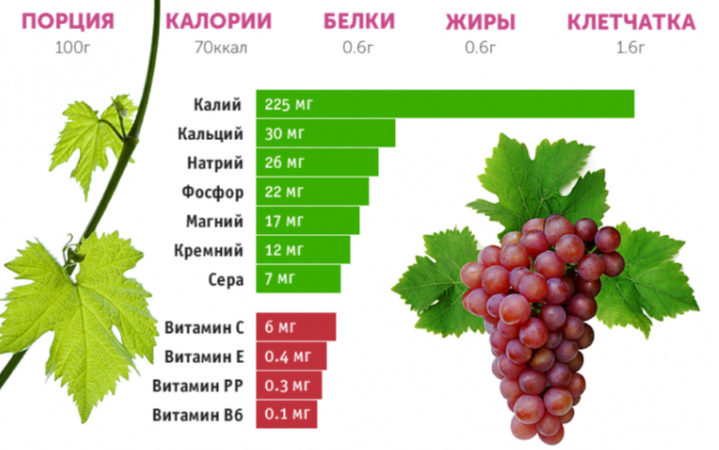What is the calorie content of grapes, and how is it good for health
Grapes are a popular and healthy berry. It is sold all year round - the bunches are imported from Turkey, Greece and Egypt, where the plant bears fruit all year round. According to nutritionists, ripe grapes contain many useful vitamins and minerals. How many pieces are in 100 grams and what benefits the berry brings to the body, we will tell in the article.
The content of the article
Calorie content of grapes
In autumn, many varieties of grapes for every taste appear on store shelves: with or without seeds, black, green and red. They have different properties, calories and glycemic index.
Are grapes high in calories

Caloric content directly depends on the percentage ratio between glucose and fructose. The more acidic the berry, the fewer calories it contains, and vice versa.
The average value of the indicator for grapes is from 65 to 73 kcal per 100 g, but depending on the variety, the calorie content changes (kcal):
- white raisins - 71;
- black raisins - 65;
- Ladies' fingers - 60.33;
- Isabella - 67;
- pitted green - 69;
- green with seeds - 65;
- white - 60;
- red grapes - 72.
Glycemic index (GI)
GI is a measure of the effect of a product on blood sugar levels. The higher it is, the faster carbohydrates are broken down, respectively, a person experiences less saturation after eating. In addition, the body does not have time to assimilate all carbohydrates, they are transformed into visceral fats.
The glycemic index of grapes is quite high, with an average of 45 units. However, this indicator varies depending on varieties... So, in dark berries it is lower and ranges from 43 to 54 units, and in light berries it can be from 45 to 60.
Attention! Due to the high glycemic index, grapes are not recommended for patients with type 1 and type 2 diabetes.
BZHU
100 g of grapes contain:
- 80% water;
- 1.6 g dietary fiber;
- 0.6 g protein;
- 0.2 g fat;
- 15.4 g of carbohydrates, which is the same as 250 g of unsweetened grapefruit.
The amount of carbohydrates in grapes depends on the region of growing berries and their purpose (fresh consumption or for further processing).
The maximum carbohydrate content per 100 g was found in the following varieties:
- Isabella - 16.67 g;
- red grapes - 16.63 g;
- raisins - 16.7 g
Composition and properties
Grapes contain many vitamins, useful trace elements, minerals. There is even a special direction in alternative medicine, which is based on the treatment of these berries and products based on them.
Grapes are valuable in everything from the peel to the seeds, which are high in antioxidants, including resveratrol, which is responsible for blood sugar and cardiovascular health.
Berries also contain:
- beta-carotene - essential for eye health and protection of the retina from sunlight;
- lutein - binds and removes free radicals;
- lycopene - improves memory and thought processes;
- quercetin - belongs to the group of flavonoids, cardioprotector;
- ellagic acid - one of the most effective antioxidants, helps to remove phenolic compounds from the body.
Also in the composition of grapes are:
- Vitamin C (28% of the daily dose). It is essential for the health of skin, nails, teeth and hair, it is responsible for immunity and the body's resistance to infectious diseases
- Vitamin K (27.5% of the daily requirement).Participates in the synthesis of proteins, helps to normalize blood clotting, strengthens bones.
- Copper (10%)... Without it, collagen synthesis is disrupted, tissues lose elasticity, and the process of iron absorption by the body is disrupted.
- Potassium (8%). Regulates water-salt and acid-base balances, as well as blood pressure, is necessary for the synthesis of proteins and the normal functioning of the nervous system.
- B1, or thiamine (7%). Participates in many metabolic processes.
- B6 and riboflavin (6%)... Another name is beauty vitamins, their deficiency can result in hair loss, overweight and early wrinkles.
- Calcium (2%)... Essential for bones and teeth.
- Phosphorus (1%)... Provides health of joints, teeth, internal organs.
- Manganese (5%). Participates in protein-carbohydrate metabolism and is responsible for the production of insulin.
How many calories in 100 g

Grape juice is made by cold pressing, and then pasteurized and poured into jars.
If sugar is not added in the process, then the calorie content of such a drink does not exceed 54 kcal per 100 g.
The calorie content of foods made from grapes varies by species as well as processing time.
Dried berries (raisins) retain all their beneficial properties, but the calorie content changes significantly. So, 100 g of light seedless raisins contains 262 kcal, and in the dark already 292 kcal.
The calorie content of grape jam depends on the amount of sugar, but in general it does not exceed 250-270 kcal per 100 g of product, which cannot be said about compote. This drink will contain only 77 kcal.
The energy value of the wine will depend on the strength and grape variety:
- red - 250 kcal;
- white - 100 kcal;
- dry - 80 kcal;
- semi-dry - 105 kcal;
- homemade - from 230 kcal.
Is it possible to eat grapes on a diet
Despite all the usefulness, nutritionists advise against eating grapes for those who want to lose weight. The calorie content of the product is small, but here GI is quite high... This means it is difficult to get enough of grapes as carbohydrates are quickly released, making you want to eat more.
There is practically no fiber in the berry, which can adversely affect digestion.
Benefit and harm
Grapes are an extraordinary berry, the regular use of which can have a positive effect on the functioning of the brain and nervous system.
Thanks to the antioxidants it contains, the body is cleansed of free radicals, improves the condition of the skin, nails, hair, normalizes blood pressure, increases immunity and slows down the aging process.
Grapes also have other beneficial properties:
- serves as an excellent means of preventing pulmonary and infectious diseases;
- helps to strengthen the cardiovascular system;
- reduces the likelihood of developing cancer;
- helps with liver diseases;
- removes toxins;
- prevents depression and sleep disturbance;
- normalizes metabolic processes in the body;
- prevents the development of kidney disease;
- irreplaceable in the treatment of joint pain as a source of vitamins and minerals.
The rich mineral and vitamin composition does not mean that grapes can be eaten without restrictions.
Nutritionists warn that the berry can be harmful in cases where a person has the following diseases:
- obesity;
- sugar diabetes 1 or 2 types;
- colitis (acute, chronic);
- pancreatitis;
- disorder or chronic disease of the gastrointestinal tract (including diarrhea, constipation);
- violation of microflora (for example, thrush);
- oncology (stomach tumors) and ulcers;
- allergy;
- hypertension.
It is not recommended to eat grapes for nursing mothers and young children - the berry can cause bloating in the child.
It is interesting:
Is it possible to eat grapes during pregnancy in the 1st, 2nd and 3rd trimester
How to choose and store grapes correctly so that they do not lose their beneficial properties

There are many varieties that differ in both taste and purpose.
Berries with a thin skin are not intended for long-term storage; it is advisable to use them on the day of purchase. But the "thick-skinned" varieties will calmly lie in the refrigerator for a whole week.
When choosing grapes in a store, you should pay attention to the following characteristics:
- Maturity and size of berries... Too small and immature ones hardly managed to accumulate useful substances and vitamins, in addition, they can be poisoned.
- Freshness. The stale and tarnished ones have already lost all their benefits.
- The presence of spoiled berries on the brush... If there are too many of them, the grapes were improperly transported and stored, they can be dangerous to health.
- Green leaves. If they are present, the bunches are cut correctly and the product is fresh.
Before placing the berries in the refrigerator, carefully examine the bunches and remove damaged, spoiled berries and leaves. Store them in the refrigerator, in a clean bag in the fruit and vegetable compartment. You don't need to tie a bag, just cover the top.
Attention! The package will help preserve the freshness of the grapes for several days, since it will prevent the effects of oxygen, and, accordingly, the decay process.
Consumption rates per day

According to research by the Institute of Nutrition of the Russian Academy of Medical Sciences, grapes contain hydroxycinnamic acids necessary for humans, flavanols and their glycosides, as well as gallic and para-hydroxybenzoic acids.
To meet the daily requirement for these substances, you need to eat 200-250 g of berries. You should not eat them together with the bones - the body will not be able to absorb the nutrients they contain, but the risk of damaging the intestinal walls is great.
Reference.There are about 50 berries in 100 g of grapes.
Conclusion
Reasonable use of grapes will only benefit the body. At the same time, dark berries will provide antioxidant protection, support the normal functioning of the heart and nervous system, and light berries will protect the skin from photoaging, activate cell regeneration, and saturate with microelements and vitamins.